Udo Kruschwitz
Can Language Models Critique Themselves? Investigating Self-Feedback for Retrieval Augmented Generation at BioASQ 2025
Aug 07, 2025Abstract:Agentic Retrieval Augmented Generation (RAG) and 'deep research' systems aim to enable autonomous search processes where Large Language Models (LLMs) iteratively refine outputs. However, applying these systems to domain-specific professional search, such as biomedical research, presents challenges, as automated systems may reduce user involvement and misalign with expert information needs. Professional search tasks often demand high levels of user expertise and transparency. The BioASQ CLEF 2025 challenge, using expert-formulated questions, can serve as a platform to study these issues. We explored the performance of current reasoning and nonreasoning LLMs like Gemini-Flash 2.0, o3-mini, o4-mini and DeepSeek-R1. A key aspect of our methodology was a self-feedback mechanism where LLMs generated, evaluated, and then refined their outputs for query expansion and for multiple answer types (yes/no, factoid, list, ideal). We investigated whether this iterative self-correction improves performance and if reasoning models are more capable of generating useful feedback. Preliminary results indicate varied performance for the self-feedback strategy across models and tasks. This work offers insights into LLM self-correction and informs future work on comparing the effectiveness of LLM-generated feedback with direct human expert input in these search systems.
Why am I seeing this? Towards recognizing social media recommender systems with missing recommendations
Apr 15, 2025Abstract:Social media plays a crucial role in shaping society, often amplifying polarization and spreading misinformation. These effects stem from complex dynamics involving user interactions, individual traits, and recommender algorithms driving content selection. Recommender systems, which significantly shape the content users see and decisions they make, offer an opportunity for intervention and regulation. However, assessing their impact is challenging due to algorithmic opacity and limited data availability. To effectively model user decision-making, it is crucial to recognize the recommender system adopted by the platform. This work introduces a method for Automatic Recommender Recognition using Graph Neural Networks (GNNs), based solely on network structure and observed behavior. To infer the hidden recommender, we first train a Recommender Neutral User model (RNU) using a GNN and an adapted hindsight academic network recommender, aiming to reduce reliance on the actual recommender in the data. We then generate several Recommender Hypothesis-specific Synthetic Datasets (RHSD) by combining the RNU with different known recommenders, producing ground truths for testing. Finally, we train Recommender Hypothesis-specific User models (RHU) under various hypotheses and compare each candidate with the original used to generate the RHSD. Our approach enables accurate detection of hidden recommenders and their influence on user behavior. Unlike audit-based methods, it captures system behavior directly, without ad hoc experiments that often fail to reflect real platforms. This study provides insights into how recommenders shape behavior, aiding efforts to reduce polarization and misinformation.
A Reproducibility Study of Graph-Based Legal Case Retrieval
Apr 11, 2025Abstract:Legal retrieval is a widely studied area in Information Retrieval (IR) and a key task in this domain is retrieving relevant cases based on a given query case, often done by applying language models as encoders to model case similarity. Recently, Tang et al. proposed CaseLink, a novel graph-based method for legal case retrieval, which models both cases and legal charges as nodes in a network, with edges representing relationships such as references and shared semantics. This approach offers a new perspective on the task by capturing higher-order relationships of cases going beyond the stand-alone level of documents. However, while this shift in approaching legal case retrieval is a promising direction in an understudied area of graph-based legal IR, challenges in reproducing novel results have recently been highlighted, with multiple studies reporting difficulties in reproducing previous findings. Thus, in this work we reproduce CaseLink, a graph-based legal case retrieval method, to support future research in this area of IR. In particular, we aim to assess its reliability and generalizability by (i) first reproducing the original study setup and (ii) applying the approach to an additional dataset. We then build upon the original implementations by (iii) evaluating the approach's performance when using a more sophisticated graph data representation and (iv) using an open large language model (LLM) in the pipeline to address limitations that are known to result from using closed models accessed via an API. Our findings aim to improve the understanding of graph-based approaches in legal IR and contribute to improving reproducibility in the field. To achieve this, we share all our implementations and experimental artifacts with the community.
Understanding Learner-LLM Chatbot Interactions and the Impact of Prompting Guidelines
Apr 10, 2025Abstract:Large Language Models (LLMs) have transformed human-computer interaction by enabling natural language-based communication with AI-powered chatbots. These models are designed to be intuitive and user-friendly, allowing users to articulate requests with minimal effort. However, despite their accessibility, studies reveal that users often struggle with effective prompting, resulting in inefficient responses. Existing research has highlighted both the limitations of LLMs in interpreting vague or poorly structured prompts and the difficulties users face in crafting precise queries. This study investigates learner-AI interactions through an educational experiment in which participants receive structured guidance on effective prompting. We introduce and compare three types of prompting guidelines: a task-specific framework developed through a structured methodology and two baseline approaches. To assess user behavior and prompting efficacy, we analyze a dataset of 642 interactions from 107 users. Using Von NeuMidas, an extended pragmatic annotation schema for LLM interaction analysis, we categorize common prompting errors and identify recurring behavioral patterns. We then evaluate the impact of different guidelines by examining changes in user behavior, adherence to prompting strategies, and the overall quality of AI-generated responses. Our findings provide a deeper understanding of how users engage with LLMs and the role of structured prompting guidance in enhancing AI-assisted communication. By comparing different instructional frameworks, we offer insights into more effective approaches for improving user competency in AI interactions, with implications for AI literacy, chatbot usability, and the design of more responsive AI systems.
Query Smarter, Trust Better? Exploring Search Behaviours for Verifying News Accuracy
Apr 07, 2025Abstract:While it is often assumed that searching for information to evaluate misinformation will help identify false claims, recent work suggests that search behaviours can instead reinforce belief in misleading news, particularly when users generate queries using vocabulary from the source articles. Our research explores how different query generation strategies affect news verification and whether the way people search influences the accuracy of their information evaluation. A mixed-methods approach was used, consisting of three parts: (1) an analysis of existing data to understand how search behaviour influences trust in fake news, (2) a simulation of query generation strategies using a Large Language Model (LLM) to assess the impact of different query formulations on search result quality, and (3) a user study to examine how 'Boost' interventions in interface design can guide users to adopt more effective query strategies. The results show that search behaviour significantly affects trust in news, with successful searches involving multiple queries and yielding higher-quality results. Queries inspired by different parts of a news article produced search results of varying quality, and weak initial queries improved when reformulated using full SERP information. Although 'Boost' interventions had limited impact, the study suggests that interface design encouraging users to thoroughly review search results can enhance query formulation. This study highlights the importance of query strategies in evaluating news and proposes that interface design can play a key role in promoting more effective search practices, serving as one component of a broader set of interventions to combat misinformation.
Use Me Wisely: AI-Driven Assessment for LLM Prompting Skills Development
Mar 04, 2025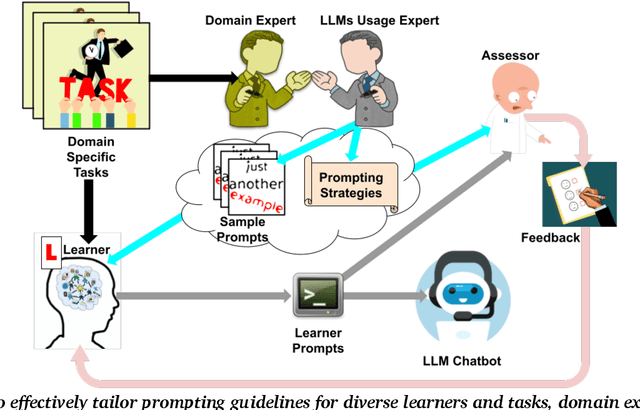
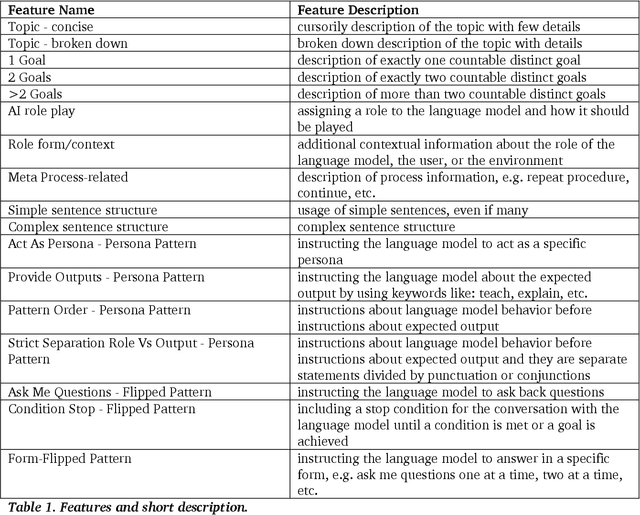
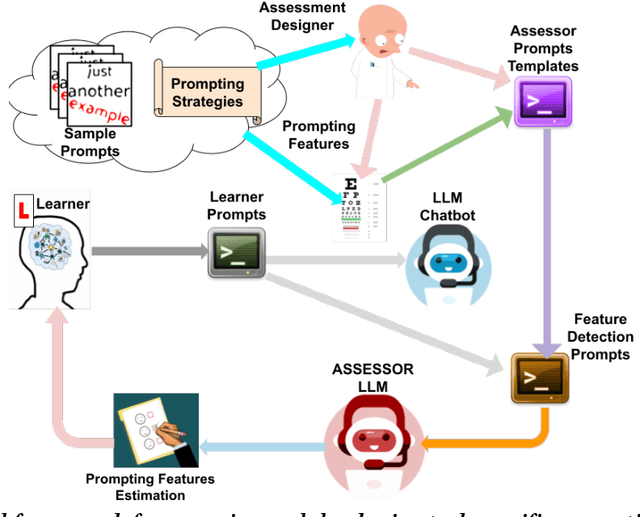
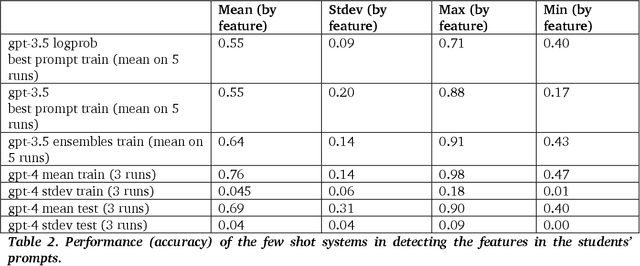
Abstract:The use of large language model (LLM)-powered chatbots, such as ChatGPT, has become popular across various domains, supporting a range of tasks and processes. However, due to the intrinsic complexity of LLMs, effective prompting is more challenging than it may seem. This highlights the need for innovative educational and support strategies that are both widely accessible and seamlessly integrated into task workflows. Yet, LLM prompting is highly task- and domain-dependent, limiting the effectiveness of generic approaches. In this study, we explore whether LLM-based methods can facilitate learning assessments by using ad-hoc guidelines and a minimal number of annotated prompt samples. Our framework transforms these guidelines into features that can be identified within learners' prompts. Using these feature descriptions and annotated examples, we create few-shot learning detectors. We then evaluate different configurations of these detectors, testing three state-of-the-art LLMs and ensembles. We run experiments with cross-validation on a sample of original prompts, as well as tests on prompts collected from task-naive learners. Our results show how LLMs perform on feature detection. Notably, GPT- 4 demonstrates strong performance on most features, while closely related models, such as GPT-3 and GPT-3.5 Turbo (Instruct), show inconsistent behaviors in feature classification. These differences highlight the need for further research into how design choices impact feature selection and prompt detection. Our findings contribute to the fields of generative AI literacy and computer-supported learning assessment, offering valuable insights for both researchers and practitioners.
Do we still need Human Annotators? Prompting Large Language Models for Aspect Sentiment Quad Prediction
Feb 18, 2025Abstract:Aspect sentiment quadruple prediction (ASQP) facilitates a detailed understanding of opinions expressed in a text by identifying the opinion term, aspect term, aspect category and sentiment polarity for each opinion. However, annotating a full set of training examples to fine-tune models for ASQP is a resource-intensive process. In this study, we explore the capabilities of large language models (LLMs) for zero- and few-shot learning on the ASQP task across five diverse datasets. We report F1 scores slightly below those obtained with state-of-the-art fine-tuned models but exceeding previously reported zero- and few-shot performance. In the 40-shot setting on the Rest16 restaurant domain dataset, LLMs achieved an F1 score of 52.46, compared to 60.39 by the best-performing fine-tuned method MVP. Additionally, we report the performance of LLMs in target aspect sentiment detection (TASD), where the F1 scores were also close to fine-tuned models, achieving 66.03 on Rest16 in the 40-shot setting, compared to 72.76 with MVP. While human annotators remain essential for achieving optimal performance, LLMs can reduce the need for extensive manual annotation in ASQP tasks.
Token-Level Graphs for Short Text Classification
Dec 17, 2024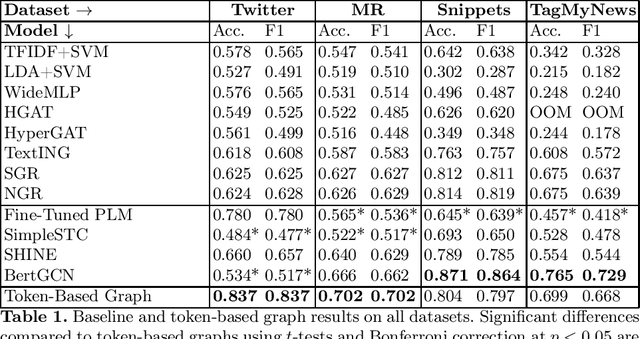
Abstract:The classification of short texts is a common subtask in Information Retrieval (IR). Recent advances in graph machine learning have led to interest in graph-based approaches for low resource scenarios, showing promise in such settings. However, existing methods face limitations such as not accounting for different meanings of the same words or constraints from transductive approaches. We propose an approach which constructs text graphs entirely based on tokens obtained through pre-trained language models (PLMs). By applying a PLM to tokenize and embed the texts when creating the graph(-nodes), our method captures contextual and semantic information, overcomes vocabulary constraints, and allows for context-dependent word meanings. Our approach also makes classification more efficient with reduced parameters compared to classical PLM fine-tuning, resulting in more robust training with few samples. Experimental results demonstrate how our method consistently achieves higher scores or on-par performance with existing methods, presenting an advancement in graph-based text classification techniques. To support reproducibility of our work we make all implementations publicly available to the community\footnote{\url{https://github.com/doGregor/TokenGraph}}.
BioRAGent: A Retrieval-Augmented Generation System for Showcasing Generative Query Expansion and Domain-Specific Search for Scientific Q&A
Dec 16, 2024Abstract:We present BioRAGent, an interactive web-based retrieval-augmented generation (RAG) system for biomedical question answering. The system uses large language models (LLMs) for query expansion, snippet extraction, and answer generation while maintaining transparency through citation links to the source documents and displaying generated queries for further editing. Building on our successful participation in the BioASQ 2024 challenge, we demonstrate how few-shot learning with LLMs can be effectively applied for a professional search setting. The system supports both direct short paragraph style responses and responses with inline citations. Our demo is available online, and the source code is publicly accessible through GitHub.
The AI Interface: Designing for the Ideal Machine-Human Experience (Editorial)
Nov 29, 2024Abstract:As artificial intelligence (AI) becomes increasingly embedded in daily life, designing intuitive, trustworthy, and emotionally resonant AI-human interfaces has emerged as a critical challenge. This editorial introduces a Special Issue that explores the psychology of AI experience design, focusing on how interfaces can foster seamless collaboration between humans and machines. Drawing on insights from diverse fields (healthcare, consumer technology, workplace dynamics, and cultural sector), the papers in this collection highlight the complexities of trust, transparency, and emotional sensitivity in human-AI interaction. Key themes include designing AI systems that align with user perceptions and expectations, overcoming resistance through transparency and trust, and framing AI capabilities to reduce user anxiety. By synthesizing findings from eight diverse studies, this editorial underscores the need for AI interfaces to balance efficiency with empathy, addressing both functional and emotional dimensions of user experience. Ultimately, it calls for actionable frameworks to bridge research and practice, ensuring that AI systems enhance human lives through thoughtful, human-centered design.
 Add to Chrome
Add to Chrome Add to Firefox
Add to Firefox Add to Edge
Add to Edge